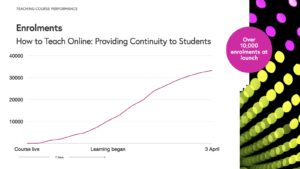Course Spotlight: How to Teach Online

At FutureLearn, we are proud to partner with educators across the globe, and as such, we’ve been keenly focused on what we can do to best support those teachers facing a significant challenge to move their face-to-face courses online and minimise disruption for their students.
As part of this, we built a course specifically for teachers who are faced with moving courses online rapidly. The course How to Teach Online: Providing Continuity for Students only opened for learning on Monday 23 March, and two weeks later already has over 30,000 teachers learning together and sharing their new approaches.
A FutureLearn first
This course is a first in many ways. For one, it’s the first time we’ve released a FutureLearn branded course, designed and built by our own Learning team, and working totally remotely. Matt Jenner, Head of Learning at FutureLearn and part of the team who worked to build this course, said: “This is FutureLearn’s first in-house course in our own brand, our own voice and luckily on our key topic, online learning. Given the situation, I couldn’t think of a better team to do this with. The FutureLearn Learning team are experts in how to teach online, our learners are experts in how to teach, the confluence of the two is powering the course! We’re all passionate about teaching and learning and that’s why we’re here and why we’re working well together.”
Not only that, but the timescale from conception to going live with learning was just eleven days. “We had the idea on a Thursday, the following Tuesday we had it open for enrollment to start learning in under a week’s time. This was an unprecedented and untested timescale.”
“We, like all teachers, have had no time to prepare or plan for this.” said Matt. “We’ve been building successful courses online for years, so felt confident to share our expertise on this topic. We just had to sacrifice a few evenings and weekends, same as the teachers, as we prepared. We built our course in the same way as teachers are – without any resource except ourselves and our platform. We had no time (no one does) and we did it with a low-fi, open access, and learn-as-we-go approach.”

A collaborative network of Mentors
The course is supported by a team of Mentors, experts from FutureLearn’s partners who nominated themselves to help us. On working with these mentors, Matt said: “Working fast and on something important was always going to elicit emotion. One wave came over me on Sunday afternoon, the day before we opened the course for learners, when I revisited a tab in my fairly loaded browser. It was a hastily put-together document that listed our Mentors, some default guidance and a table to help them sign up to offer support, advice or answer weekly Q&As. We didn’t want to overload our first run with enthusiasm so ideally we wanted to spread our Mentors out across future course runs. My colleague, Finola Lang, was on email asking Mentors for help and to join; other colleagues Felicity Parsisson, Monty King and myself were working on the course content. I was momentarily overwhelmed when I went back to the tab and found it’d been completed, over a Sunday, by over 20 respected experts across the FutureLearn partnership. The document was alive with Mentors dropping their names into the list and nominating themselves into an uncertain future going well into May. I was honoured to work alongside such experts who hadn’t even seen the course at this stage but they believed in us.”
But why is this course so important to teachers right now? “They are being placed in a very tricky position,” believes Matt. “To work in unfamiliar environments with learners who have been forced back into our homes – spaces not designed for learning. They did not have the luxury of time, they needed practical solutions and shortcuts. This style started as a hunch, so we ran a survey just before we went live – 1600 teachers responded and the overwhelming response was that they needed a course that was practice-heavy and theory-light. These teachers hadn’t taught online before and they wanted a proactive and community-driven space to help, support and guide them into a new and unknown space.”
This view is supported by many mentors on the course.
Dr Simon Rofe, SOAS, elaborates: “The greatest challenge at the moment is the immediacy of the challenge. We can’t avoid the time we are given, but taking time to listen, even 30 seconds to just reflect on a course of action, is vital.”
Mentor, Professor Lisa Harris of the University of Exeter adds: “There seems to be pressure on teachers, particularly in schools, to replicate as far as possible what they have been doing offline, rather than consider what might work best when learners are dispersed geographically, have varying levels of connectivity and bandwidth, and uncertainty in many areas of their lives.”
“Learning might be less visible and engagement may be less visible,” continues Neil Mosley of Cardiff University, another mentor on the course, “this can be unsettling and challenging if you’re new to teaching online. Remember that active and effortful learning can happen despite not being visible through people posting in places that we can see for instance.”
The course is unique in the sense that it gives teachers a chance to discuss with one another their approaches, share concerns, and reflect on their own practices: “The discussions across the course, especially in responding to participants’ pressing questions, have been incredibly supportive and positive.” says Hannah Tyreman from the Chartered College of Teaching, a mentor on the course. “One theme I have recognised is the pressure educators feel to ‘get it right first time’.”
Responding to a crisis is one thing, but the challenge over the months ahead, and beyond, is to mature our understanding of the opportunities that new digital technologies offer
Teaching after COVID-19
Although the current situation will come to an end, the impact of the COVID-19 pandemic is likely to leave its mark on the world of teaching: “Although it has somewhat forced people to transition very rapidly, I think with the right support, educators will hopefully see the benefits of moving to a much more blended model of learning.” says mentor, Dr Angela Davies from the University of Manchester.
Professor Mark Brown of Dublin City University adds: “Certainly the pivot to rapidly teach online has forced us to think around corners and in many respects fast-track the future. While history teaches us to be wary about making bold speculative predictions of the future, it’s highly probable that ‘online education’ will never be the same again. Responding to a crisis is one thing, but the challenge over the months ahead, and beyond, is to mature our understanding of the opportunities that new digital technologies offer for a more transformative model of education which prepares students for tomorrow’s world, today.”
The course How to Teach Online: Providing Continuity to Students may be a rapid solution to a very current issue, but the potential for a long-term supportive network of educator peers to experiment and understand what works, together, is huge. “We can’t fix all the complex problems of the online pivot;” says Matt “our goal is to reassure teachers, help them be compassionate to themselves and put best practice in place for their students. We want to remind them they’ll make mistakes but if they get feedback, reflect and make changes it’ll get better and they’ll be OK!”
The course How to Teach Online: Providing Continuity to Students is open for enrolments now. The next run of the course will begin on 27 April. Please feel free to share this resource with your networks.




